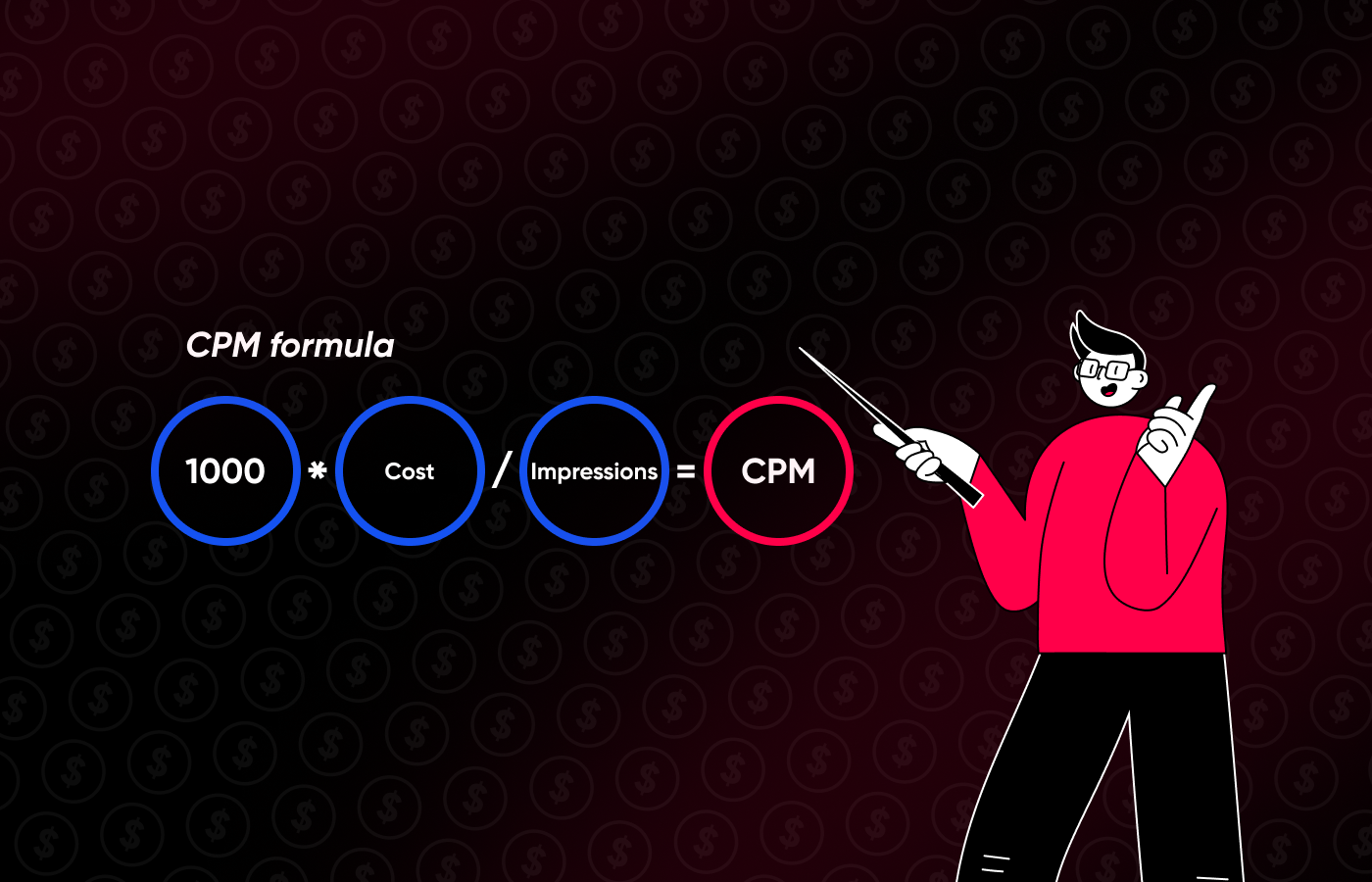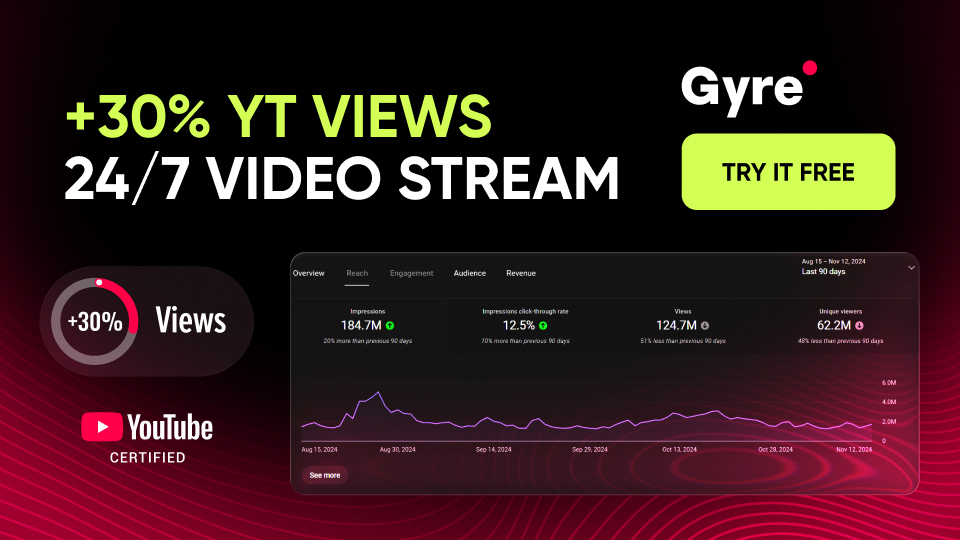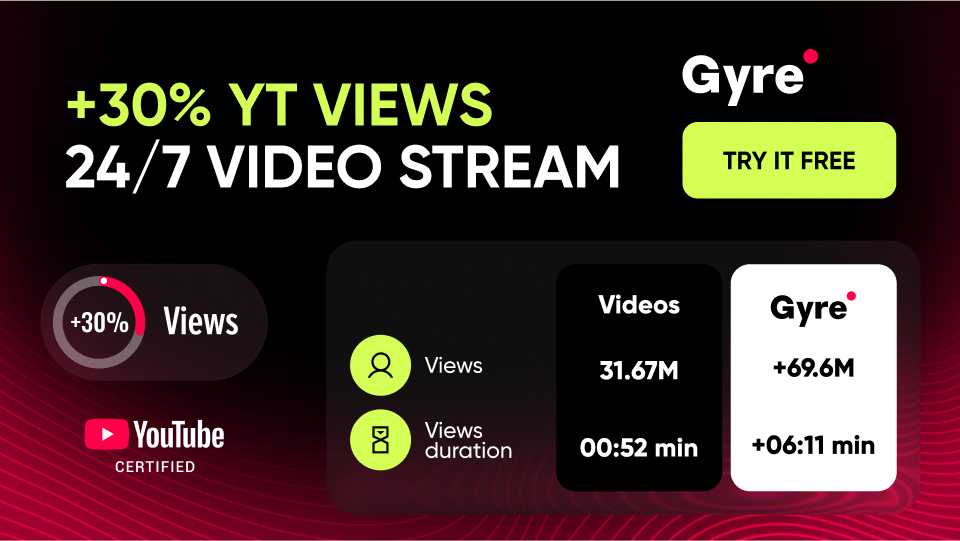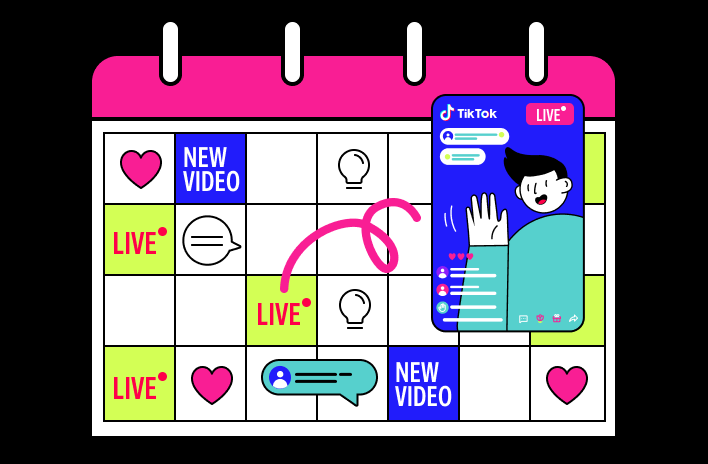What is CPM?
CPM (“Cost per Mille”) — “cost per 1000 views.”
To clarify, CPM applies to views only from those videos with advertising.
That is, these are funds that the advertiser pays every time a thousand views are gained from a video with advertisements shown during the playback of a regular creator's video on the channel.
Simply put, these are funds earned for commercial breaks that appear while watching a YouTube video.
Here's how it works:
- An advertiser wants their commercial shown to a specific audience that views content matching their interests on a video hosting service.
- YouTube is happy to place the provided commercial on content popular with the audience (on videos with high average duration view) and to receive money for it: 45% of the total cost per 1000 impressions.
- The channel owner where the commercial content was integrated receives 55% of the total cost for every 1000 impressions.
How to calculate CPM for YouTube
The cost per thousand impressions is calculated according to the following formula:
CPM = (Total revenue from advertising ÷ number of commercial impressions)×1000
What you need to know about CPM:
- The cost per 1000 views varies depending on the niche and the channel topic.
You've probably heard that the YouTube advertising segment categorizes audiences as more or less profitable.
The narrower the topic on YouTube, which is of interest to a specific target audience, the higher the cost of advertising on such videos, especially if this audience is interesting to advertisers.
- CPM is the amount advertisers pay to have their ad appear on particular video content. This amount also depends on the number of competitors (who are also interested in placing commercials on similar content). Do you want your ad to be shown? Then you have to pay. And pay more than your competitors.
- The more competition among advertisers wanting to show ads with your content, the more expensive it will be to show ads (consequently, the more money the content creator will receive).
Why is my CPM decreasing?
CPM is not a constant and can either decrease (unfortunately) or increase (oh, that this would always be the case. So let's break down the main factors that affect CPM.
Average Duration View and Watch Time
Average duration view, watch time and CPM are closely intertwined. The higher the retention, the more ads YouTube can show on your videos.
Accordingly, it is more profitable to show advertising on longer videos with high average duration view because: a) you can place more advertising, and b) for the viewer, watching the video will not turn into just watching ads.
Channel Niche (Topic)
If you have not yet created your channel but plan to, we recommend you first read the various studies on the popularity of niches and their CPM, depending on the geolocation of the audience you plan to target.
We checked niche popularity on Google and found an article listing popular niches (topics) and CPM rates. Here are some of them; you can find a more detailed list in the article.
Niche | CPM rate |
Make Money Online | $13.52 |
Social Networks Marketing | $12.41 |
Finance and Investments | $12.25 |
Educational Videos | $9.89 |
Photography & Film Making | $9.22 |
Topic Transparency
If you want to earn from advertising, the subject of your content must comply with the video hosting rules and not contain prohibited topics (cruelty, violence, etc.). As soon as YouTube is suspicious of streams on any topic that violates platform rules, this will immediately affect at least the monetization of the content, and at most, the channel will be blocked.
Children's topics will also be an exception, although this is a non-prohibited niche. It is almost impossible to make money from children's content.
Seasonality
It is necessary to prepare for the reality that some months will be unsuccessful and you cannot change it. For example, December may be the most profitable month, as advertisers are investing as much as possible for winter/Christmas campaigns, so January may be a quieter month.
Geolocation and Age of the Audience
First, CPM depends on the audience for which ads are created. So, advertising costs depend on each country’s economic situation, the GDP indicator, and the population’s average level of income. For example, the cost of setting up an ad for the same target audience of “young middle-class parents” will depend on whether these people live in Switzerland or Greece.
In addition, the cost of advertising will depend on the target audience’s age range.
From this, we can conclude.
The higher the income of your audience and the more it is focused on a particular interest (i.e., your channel has gathered a narrow circle of people with 1-2 interests), the more attractive your audience is to advertisers, resulting in a higher CPM on your channel.
What is RPM?
Next to CPM is another metric — RPM.
RPM (Revenue Per 1,000 Impressions) is a relatively new metric for estimating the revenue per 1,000 views on videos from various sources: advertising, YouTube Premium subscribers, or revenue from Super Chat, Super Stickets, and sponsors.
Revenue per thousand impressions is calculated according to the following formula:
RPM =(Revenue ÷ number of views)×1000
RPM is valuable because it reflects the creator's total revenue (advertising + other areas of monetization) after YouTube deducts its share.
While CPM reveals to creators that their content interests advertisers, RPM tells them how valuable it is to audiences and brands.
RPM is about selling goods/services both on and off YouTube (brand deals or sponsorships; affiliate sales included).
In the context of making money on YouTube, we recommend that you not only rely on CPM and advertisers but also interact with your audience.
Ways to Increase Your CPM on YouTube
2 vectors will help you increase your channel CPM. The first direction requires changes in content creation, and the second in optimizing existing content.
The first direction should include the following.
Create videos with a duration of at least 10 minutes
If you have mostly short videos on your channel, we recommend you create new longer ones. Here, the task is to increase views and hold the viewer’s attention.
Several tricks will help if it’s not possible to make videos longer:
- Create a compilation of longer videos based on existing content. As an option, create summaries on your topic or a retrospective for a certain period of time. In this case, longer videos are safe to create because they can also interest viewers.
- Conduct live streams. After their completion, save them on the channel to form a new channel section or a playlist. Streams will help you stay in touch with your audience and increase average duration view.
Continuous streams will come to the rescue if your channel topic does not allow you to conduct live streams or a live dialogue with the audience.
Continuous streams are a lifeline for many channels that can’t make long videos or conduct live streams.
A continuous stream is a stream created from existing clips and played on repeat 24/7, creating an endless video stream. You choose one or more video files to stream. Viewers watch the stream in live mode, and the video then loops from the beginning once the video ends. Moreover, average duration view is much higher on such streams, significantly affecting the average viewer retention rate across the channel and advertising.
There are two screens in front of you. The first one shows that channel viewer retention before February 17 was at 2 ½ minutes. After the start of continuous streams, average duration view rose at 1 minute and 17 seconds. And this stream ran only for a few days.
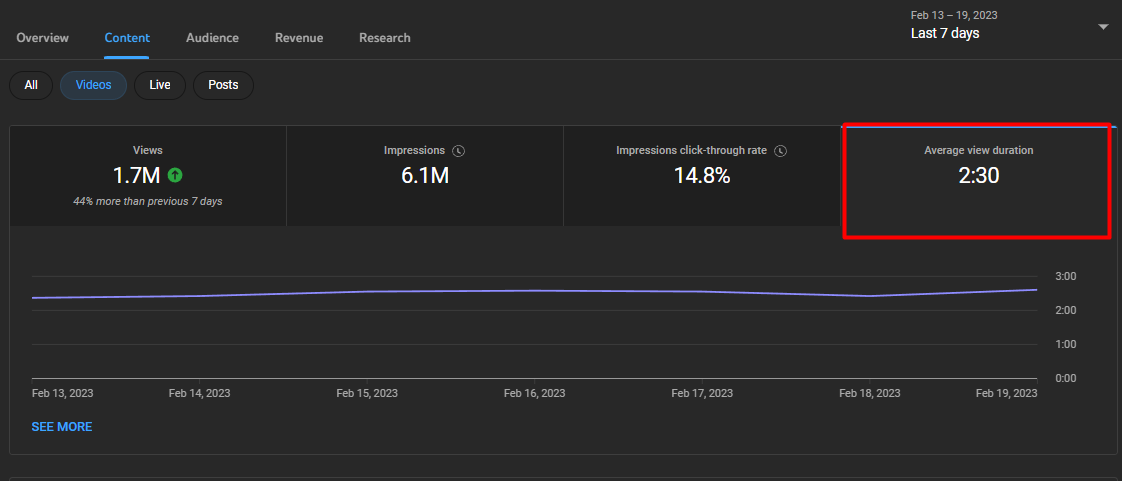
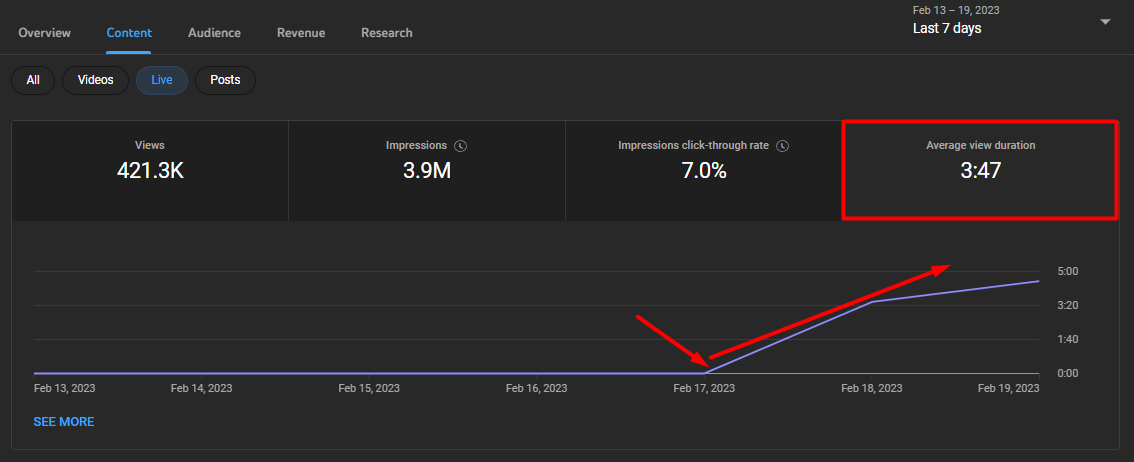
Again, live and continuous streams significantly increase your reach and drive more targeted traffic and subscribers to your channel. Because streams have high average duration view, the algorithms promote them better, and by launching streams, you also increase the percentage of streams watched by a new audience.
Again, these screenshots show that, on average per channel, videos hit the recommended level 72% of the time, while streams hit it 96% of the time.
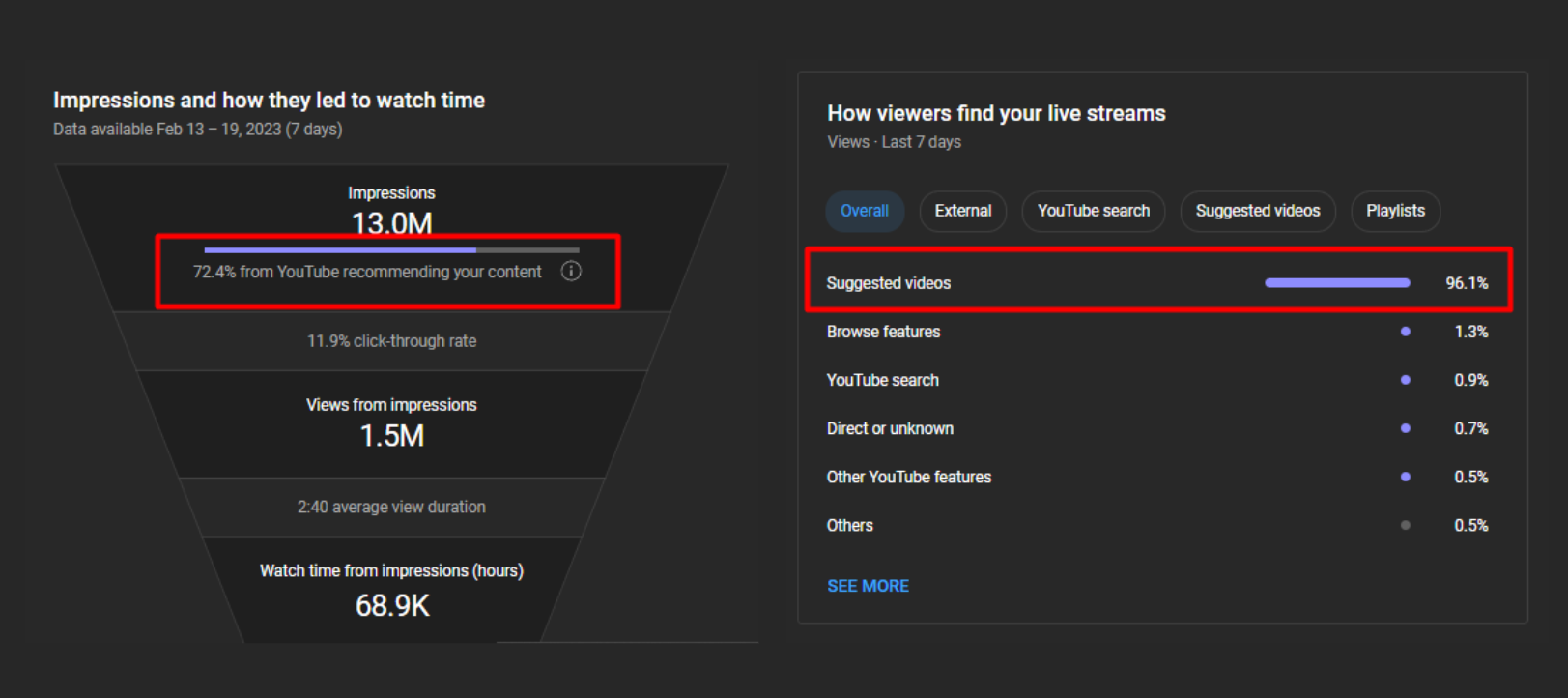
Read our article for more on creating continuous streams and the superpower they give to channels.
Focus on one topic when creating content
A bit of obvious advice, but still, you shouldn't go crazy trying to create videos on different topics for one YouTube channel just to cover expensive niches and get more profit. If you have already chosen your topic, continue creating worthy content in your niche.
The second direction includes the following.
Increasing average duration view and watch time on existing videos
Change your video metadata so that YouTube re-indexes your video and serves it to new viewers. Your video will get more views and bring new users to the channel, who will then go to other videos on your channel. Also, changing or correcting the metadata will help raise the CTR of the channel.
Choose the right keywords for your videos and add them to your tags
We recently wrote more about tags and how to set them in this article.
Work on the reputation of your channel
Increasing your CPM and RPM on YouTube is a gradual and painstaking endeavor, but not impossible. So we wish you patience and perseverance in increasing your income.
And, if you’re interested in continuing streams as one of the ways to increase CPM, you can sign up for a free 7-day version of our service and start streaming today to significantly increase the reach and average duration view of channel viewers.


